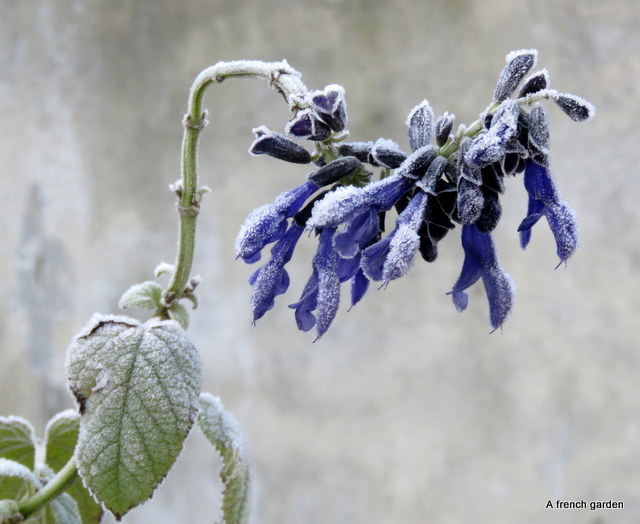
This morning we awoke to the first frost of the winter. Until now it has not really been cold but this year France has had 32 continuous days of rain. You have to go back to 1988 between the 12 January and 12 February to find a similar number of continuous days of rain and even then considerably less rain fell. Considering that France started the year from 21 January to 21 February with no rain then you can understand it has been a difficult year for gardeners.

We are well behind with the gardening work but at least the uncut sedums look pretty when frosted.

My Hydrangea brought from the Savill gardens moved this year to a better place, has not only survived but managed to look attractive right up to the frost.

I was so pleased that my Salvia leucantha survived its first year in the soil. I suppose the frost will finish it off but I hope it will be happy to be cut down and covered with a fleece.

I have no such fears for my blue Salvia that grows like a weed and pushes up shoots of two and a half metres in a season. It does provide good colour at this time of year.

The Mahonia “Charity” is also providing colour but no bumbles bees were willing to brave the cold to visit it this morning.

We noticed flowers on our flowering cherry “Accolade” a few days ago. The flowers look as pretty as they usually due when they flower in March – their normal flowering time.

I think the rain and the relatively mild weather has encouraged a lot of the plants, like this Hypericum, to flower.

The saffron greens have been frosted. They did get lots of rain after flowering but not much sun to enrich the bulbs for next year.

The cotoneasters and …

the flowering apples have given a good crop for the birds this winter, despite the dry summer.

The garden survived the drought better than I expected but perhaps a lot of our plants were well established. The Eriobotrya tree is full of flowers.

What did surprise me this morning was the perfume emanating from the flowers even frosted and at a low temperatures. Such a lovely tree. We rarely get the fruit here as the fruit matures at the coldest time of our year.

The rain has filled up the little river at the bottom of our garden. Luckily we are above the level of the surrounding fields that provide plenty of soakaway. The neighbouring city of Saintes was flooded in places but the Charente often breaks its banks and the people who live beside it are amazingly stoic bout the regular flooding.

























































































































